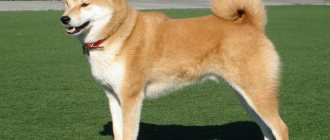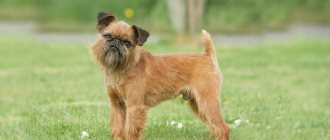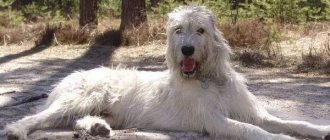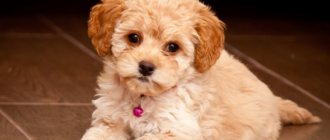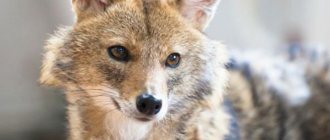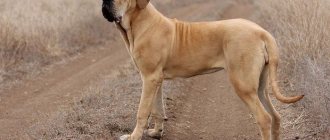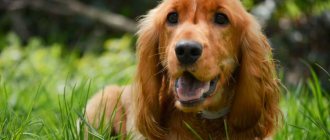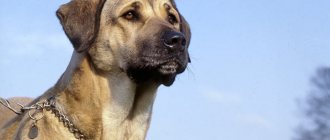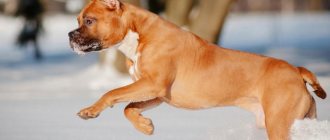Shiba Inu for real amazing hunting dog Japanese blood. Translated from Japanese, the word “Shibu” means small, and “Inu” means dog. The wayward breed, similar in appearance to a fox and its larger brother Akita Inu, known throughout the world from the film Hachiko, has a reddish-white coat color, an elongated muzzle, cunning squinting eyes and pointed ears.
Considered one of the most ancient dog breeds , in the past they were used to hunt small animals and birds. When united in a pack, inus are able to compete even with a deer or bear.
Story
The Japanese Shiba Inu dog breed, which has existed for more than 3 thousand years, is loved in Russia. It was successfully used for home protection and hunting. After World War II, the Shiba Inu breed was on the verge of destruction. The number of dogs was restored thanks to Japanese dog handlers. In Russia, such a dog appeared at the end of the 20th century and managed to gain popularity due to its simplicity in maintenance and funny appearance.
Description
The dog's physique is proportional to:
- strong small head;
- elongated muzzle, reminiscent of a fox;
- straight back without deflection with moderately developed muscles;
- the tail curls into a ball;
- ears are erect, according to the standard.
In the description of the breed, a distinctive feature worth noting is its funny facial expressions: the dog can really smile. When properly raised, the Shiba Inu has courage, a strong character, and is friendly towards children. The breed's character is characterized by such qualities as curiosity, sociability, and a desire to learn new things.
Shiba Inus are capable of producing amazing sounds that resemble human speech.
How to train correctly and what commands to teach?
The main aspect of raising a Shiba Inu is the inadmissibility of frequent rewards with treats, otherwise the dog will begin to cheat and beg for treats..
The second important aspect is the inadmissibility of shouting and corporal punishment. The dog must understand the intonation of the owner’s voice and gaze.
First of all, the puppy should be accustomed to its name, and then start giving commands.
The first command a dog should know is “place” . To teach this to your puppy, take him to his place every time he wants to sleep. At the same time, say the command loudly several times.
The next important command is “fu” . Whenever the puppy does something inappropriate, say the command sternly and loudly and distract the puppy with other actions.
The “come to me” command is also considered one of the main ones . Start learning at home. Call the baby by name and say loudly: “Come to me!”, while tapping your hand on your thigh.
When your pet follows the instructions, praise him or give him a treat. A little later, training continues on the street.
Varieties
Such a dwarf dog has a height at the withers of 19-30 cm. But the size of the pet does not fit the standard. There is no official recognition or registration of the breed. The distinguishing feature is the color of the coat. The main colors that are accepted by the breed standards:
- Red is considered the most common. Rich, without a tint of orange. The undercoat of dogs is white or ash-gray. This color includes red fur with small patches of black fragments.
- Black and tan, in the bright sun the hair shimmers with all the colors of the rainbow. The undercoat of such individuals is white or ash-gray.
- Black and red sesame. The base is red, with uniform patches of resin color along the body.
White dogs look presentable, but according to standards they are subject to rejection.
Experienced breeders believe that the final color of a dog’s coat is established by the age of 3-5 years.
Character and appearance
The following factors influence the formation of a dog's temperament:
- Socialization. The sooner you introduce your Shiba Inu puppy to the outside world, the sooner the pet will adapt to life with a person.
- Upbringing. Without training, the dog will be uncontrollable.
- Heredity. Puppies of this breed receive their temperament from their parents.
Characteristic features of the Shiba Inu breed: self-confidence (the desire to run away from the owner). Therefore, you should not let your dog off the leash. In excitement, the pet will rush after a bird or cat and get lost.
Mating
The Japanese Shiba Inu dog breed is rarely found in Russia, so finding a suitable partner for mating is quite difficult. Only sexually mature and fully formed animals that are 1.5 years old are allowed to reproduce.
The best days for dogs to mate are from 10 to 15 from the start of estrus. The animals are first introduced on a walk, then the bitch is brought to the male.
Dogs are most often bred in a freestyle manner - human intervention is required in rare cases. After 24-48 hours, a control mating is carried out to increase the likelihood of conception. Pregnancy of a Shiba Inu lasts 58-66 days. 4-6 puppies are born in a litter.
Raising and training Shiba Inu
Dogs of this breed are distinguished by high mental abilities. But due to their stubborn nature, raising a little Shibu is not easy. The owner should show patience and affection in training the pet. But rude shouts will make the dog angry and discourage him from following commands. Playful activities using treats as encouragement will allow you to establish contact with your pet. The carrot and stick method will not work in this case. Also, repeated repetition of the same command quickly gets boring for such a dog, and the Shiba Inu simply loses interest in the process. It is recommended to take a special training course, where dog trainers will teach the owner how to properly handle the pet.
Expert opinion
Anna Abramenko
An avid dog lover. Experience in veterinary medicine since 2009.
Ask a Question
What you should pay attention to is the timely training of your Shiba Inu to walk on a leash. Otherwise, there will be problems with walking the dog in the future.
Boy
The weight of males reaches 10–13 kg, height – 38–42 centimeters.
Males are usually larger in height and weight. Males should have wider muzzles. Females are generally smaller.
A properly raised male is more friendly and interested in making new acquaintances than a female. On the other hand, a poorly behaved boy may be angry and want to dominate.
There is also a difference between intact and castrated males. Intact individuals more often have a predisposition and desire to dominate compared to castrated ones.
Due to the hormone testosterone, boys may be more active than girls.
Most experienced owners recommend taking males for the first time. They are usually more sociable, affectionate, and easier to handle.
What is the difference between a Shiba Inu and an Akita Inu?
The Akita Inu breed also has a second name - Japanese Laika.
The table shows the main differences between the breeds:
| Options | Akita Inu | Shiba Inu |
| Height at withers (in cm) | 60-70 | 35-40 |
| Weight of an adult dog (in kg) | 30-40 | 8-10 |
| Prices of puppies (in rubles) | From 20 thousand | From 35 thousand |
| Temperament | Characterized by independence and devotion. Does not recognize other pets in the same territory | Needs constant communication. Good with pets and children |
Even more information can be found in the article “How to distinguish a Shiba Inu from an Akita Inu”
Development from 1 to 12 months
The table below shows how the average size of a Shiba Inu changes as the puppy grows.
| Age in months | Size | Weight | Description |
| 1 | 10-14 | 400-600 g | In the first two weeks after birth, the puppy is completely helpless. After the second week of life, the baby can already see and hear. And by the end of the first month, he eats independently and masters the world around him. |
| 2 | 16-18 | 2.3-3 kg | The baby is getting teeth, he is actively growing and socializing. During this period, the puppy is taken away from its mother. |
| 3 | 18-22 | 3-4 kg | Socialization and growth continues. At this age, leaders begin to emerge. |
| 4 | 22-25 | 4.5-5.5 kg | The puppy enters adolescence, baby teeth are replaced by permanent teeth, and the formation of its own immune system occurs. |
| 5-6 | 26-30 | 5.6-8.7 kg | The second stage of socialization, at this age dogs often fight for primacy and leadership. The reason is entering the puberty phase. |
| 7-9 | 27-33 | 9-15 kg | Bitches begin their first heats and growth slows down. The dog does not gain weight so quickly and becomes like an adult dog. |
| 10-12 | 30-35 | 15-25 kg | The end of puberty and character formation. Now she is a young adult dog. |
Care and maintenance
The Shiba Inu breed is suitable for keeping in a small apartment. Nevertheless, the dog is active and needs increased physical activity and long walks to release energy. A country house with a large enclosed area will be an ideal place for a pet.
To care for such an animal, no special skills are required. Shiba Inu only needs to be brushed frequently and bathed once every 3-4 months, using a special shampoo. You should also monitor the condition of the dog’s ears and the length of the dog’s nails. Even a novice breeder can maintain and care for such a pet.
Dog character
By nature, the Shiba Inu is loyal and devoted. But they do have some natural traits and instincts that you need to be aware of.
- The dog's character is that he is independent and very pure. Before buying a new pet, many people are concerned about the question: does it smell like a dog? This breed grooms its fur like a cat. Therefore, there is no smell coming from it at all.
- The pet loves when its owners are nearby. However, they are often aloof, like cats. Animals don't need or want human attention most of the time.
- This is not a noisy dog. However, when strange people or sounds appear around the house, the animal will bark to alert its owners.
- The pet does not bark very loudly, but it has a wide range of “vocal styles”. Your dog will quickly learn to use his screaming against you if you let him.
- The breed is graceful and agile. She can jump over high fences and run away from home. You must wean your pet from this from childhood.
- The Shiba Inu can quickly learn a set of commands. But the animal thinks that it is much smarter than you. Therefore, the pet obeys only when he wants it.
- The dog may have a small body, but inside he has a big personality. If the species were human, it would probably be completely selfish.
- The dog is very smart. Most often, he uses his mental powers to “pressure you” and get what he wants.
- Beware of your pet's gaze. This is one of his most powerful weapons. The individual will use it with great success if he senses any weakness in you.
- Animals are extremely touchy. If they are in this state, they may snap or bite anyone who approaches them.
- The dog doesn't like to be touched. Nail trimming, bathing, or veterinary examinations are never fun for this pet.
Nutrition
At an early age, puppies are fed 5-6 times a day, from two to four months - 4-5, up to seven - 3-4. Upon reaching 8 months of age, the dog is transferred to two meals a day. And this regime should be observed constantly.
A common question that a novice breeder has is: which food is better, natural or dry. Both types of nutrition have pros and cons. Adherents of granulated ready-made feeds are inclined to this option due to its ease of use. They are confident that the pet is provided with the necessary proteins, fats, carbohydrates, and microelements. But high-quality food is expensive.
Expert opinion
Anna Abramenko
An avid dog lover. Experience in veterinary medicine since 2009.
Ask a Question
When using dry food, monitor your pet's drinking regime. Fresh water should always be in your pet's bowl.
People who feed natural food believe that only fresh food will give the dog everything it needs. But in order not to harm your pet, it is important to know the list of necessary and dangerous products.
List of useful ingredients:
- beef, rabbit meat;
- sea fish;
- fermented milk products;
- fresh vegetables and fruits;
- cereals - rice, buckwheat.
List of prohibited products for the breed:
- chicken meat;
- River fish;
- legumes;
- sweets;
- smoked and spicy dishes;
- eggs;
- spices.
Proper nutrition will ensure your pet has a long and healthy life. When feeding the Shiba Inu naturally, vitamins and microelements are added to the food, which must be selected by a veterinarian.
Do not mix natural and dry food.
Breeding
The first heat in girls begins at 5-6 months. However, a bitch can be bred from the age of 7-12 months.
Females come into heat once or twice a year. It lasts approximately 21-28 days. At this time, the bitch begins to have bloody discharge and an unpleasant odor. 10-15 days are the most suitable for mating.
Before mating, you need to prepare the future parents. Carry out deworming and vaccination a month in advance. Two weeks before the expected date of breeding, start feeding the expectant mother high-protein foods.
Pregnancy of individuals lasts 58-68 days. You need to prepare the birthing area in advance.
If your girl is giving birth for the first time, ensure that an experienced breeder or veterinarian is present at the birth. They will be able to help if the dog cannot cope on its own.
On the day of birth, the girl will lie down a lot, her basal temperature will drop to 37°C.
At one time, the bitch gives birth to 2-3 puppies. A newborn baby weighs 400-700 grams.
Health
Shiba Inus were formed in cold climates, so the dogs have stable immunity. But there are a number of hereditary diseases characteristic of this breed:
- allergy;
- joint dysplasia;
- cataract;
- hypothyroidism
If your pet’s behavior is no longer the same as before, or the body temperature has increased, it is better to contact a veterinarian.
Expert opinion
Anna Abramenko
An avid dog lover. Experience in veterinary medicine since 2009.
Ask a Question
To avoid life-threatening infections such as rabies and plague, dogs are required to be vaccinated. Timely immunization measures will protect your pet from terrible diseases.
Price
Before purchasing a puppy from a nursery, take a closer look at how they are kept there and meet the baby’s parents. Be sure to check the necessary documents and certificates. The price of a Shiba Inu depends on the class of the pet. There are three standard options:
- Show class - elite kids with impeccable pedigree, good data and chances of winning in exhibition events. Such a purchase would cost around $2,000.
- Breeding class – healthy pets with good pedigree, ambitions and prospects for participation in exhibitions. The price varies from 1000 to 1500 dollars.
- Pet class - purebred puppies that are slightly below the standard. Usually they are taken by those who dream of getting a new friend and a real family member. They are not used to participate in events. On average, such pets cost $300-500.
In any case, you should choose a puppy only in a specialized, proven nursery, where they devote time and worthy attention to this particular breed. The condition is dictated by the need to properly raise the dog.
Due to the similarity in appearance but difference in size, the Shiba Inu is often considered an Akita Inu puppy.
Advantages and disadvantages
Positive character traits and characteristics of the Shiba Inu include:
- courage;
- survivability;
- dedication;
- cheerful disposition;
- cleanliness (no unpleasant odor);
- small size (such a dog is an excellent option for keeping in an apartment).
Among the disadvantages of the Shiba Inu breed, they note a stubborn character, wayward behavior, difficulties in training, and difficulties in getting used to a leash.
List of suitable nicknames
The puppy’s name should be given to him sonorously and not long, so that the pet can quickly remember it. Some breeders require that the name of the Shiba Inu include the name of the kennel and the nicknames of the parents. In this case, the passport nickname will be complex, but in everyday life you can use its simplified version.
Exotic nicknames with an oriental touch are suitable for Shiba Inu:
- Ask, Auchi, Buran, Belle, Beauty, West, Velda;
- Grammy, Girr, Giro, Derk, Eks, Ekka;
- Julie, Joseph, Zif, Zaura, Irs, Yokki, Iota;
- Casta, Queen, Roots, Luke, Link;
- Mazur, Malva, Mint, Molly, Norris, Nyagu, Narsis;
- Olipmic, Ora, Pegasus, Prana, Ross, Rakumi;
- Samura, Sate, Takeshi, Tracy, Unta, Uncha, Uchi;
- Franz, Fiji, Habi, Hooch, Hill, Hitach;
- Cicero, Zweig, Cherry, Chaos, Shitani, Storm;
- Eiris, Eriming, Yuska, Jurvis, Yatago, Jania.
Selection rules
To purchase a Shiba Inu puppy for the purpose of further breeding, it is advisable to contact a nursery whose owners will guarantee the purity of the breed. Specialists must answer all questions about caring for and raising a dog.
Expert opinion
Anna Abramenko
An avid dog lover. Experience in veterinary medicine since 2009.
Ask a Question
When choosing a pet, you should pay attention to the activity of the Shiba Inu. It is not recommended to take a baby who shows signs of cowardice. The puppy should have clean eyes and ears, no discharge and shiny, bald hair.
It is also advisable to look at the pet’s parents and find out what kind of dog the Shiba Inu will turn into when it grows up. An inspection of the room where the babies were born and live with their mother will also give a complete picture. The dog's bed should be clean and well-groomed. A decent breeder will not interfere with the arrival of a buyer. If he refuses to meet you directly at the kennel, then it is better to refuse to purchase a dog in this establishment.
How it develops day by day in the first month
| Age (days) | Baby development |
| 1-5 | At this age, the puppy is completely dependent on its mother. All he can do is suck, squeak and crawl around. A newborn puppy lacks vision, hearing and thermoregulation. |
| 6-8 | During this period, the pet is actively gaining weight. By the end of the first week, the dog weighs approximately 2 times more. |
| 9-10 | In the second week of life, the baby not only increases in weight, but also in strength. Now you can easily identify stronger and weaker individuals. |
| 15 | Starting from this period, the puppy's eyes gradually open. He reacts to light, but does not yet know how to navigate in space. The baby begins to develop its own thermoregulation, vision and hearing. Dependence on the mother becomes less. |
| 16-18 | The puppy already sees and hears well. |
| 19-22 | The first teeth are erupting. |
| 23-24 | Interest in solid food appears, the puppy learns to bite and chew. During this period, he begins the first stage of socialization. |
| 25-30 | The puppy is much less dependent on its mother, eats solid food, shows interest in its surroundings, and actively plays with its brothers and sisters. |
Interesting Facts
- In Japanese, the Shiba Inu breed name means “small dog from the bush.”
- Such a dog makes sounds similar to humans and even copies the speech of children. The pet is able to show its mood with facial expressions. The dog is especially good at smiling.
- The Shiba Inu dog played the starring role of a child Akita Inu in the movie Hachiko. The creators thought that this particular puppy would look better.
Breed standard
In addition to the FCI, three Japanese societies have their own breed standard for the Shiba Inu: Nippo, the Japanese Kennel Club and Shibaho. Since at international exhibitions dogs are judged according to the FCI description, we will consider it.
The FCI classifies the Shiba Inu in Group 5 - Spitz, Section 5 - Asian and related breeds. He describes the Shiba as a small dog, harmoniously built, healthy and resilient, with elegant movements.
Shiba at the exhibition
Breed Description The FCI only regulates the growth of the Shiba Inu. The height of females at the withers reaches 37 cm, males - 40. Deviations of 1.5 cm up or down are acceptable.
Head and muzzle
The Shiba Inu's head is slightly elongated and pointed, resembling a fox's. The forehead is flat, divided by a small furrow. The muzzle is wide at the base and tapers towards the nose. Cheekbones are pronounced.
Jaws and teeth
Only a scissor bite is allowed. The teeth are strong, without defects or chips, strong.
Nose
The bridge of the nose is straight. Black color of the lobe is desirable, but other dark shades in harmony with the coat color are allowed.
Eyes
Small, almond-shaped, located closely. Color - rich brown.
Ears
Small, triangle-shaped, standing, pointed and slightly tilted forward. The auricle is light and dense to the touch.
Neck
Harmonious in relation to the body and head. Thick, powerful, with pronounced muscles.
Frame
The body is dense, close to a square format. The deep, moderately rounded chest flows into a straight and strong back, and that into a wide and muscular lower back. The stomach is tucked.
Limbs
Straight, medium length, with well-developed muscles. The fingers are curved and pressed tightly. The claws are hard, preferably dark in color.
Tail
It stands high, curls into a ring or curves like a sickle. Thick along the entire length and abundantly covered with hair.
Wool
Double fur coat. Consists of soft, dense undercoat and hard, straight guard hair. The coat is slightly longer on the tail, but does not form feathering or dewlap.
Defects in appearance and disqualifying defects
Any deviations from the characteristics of the breed are considered a disadvantage and a reason for reducing the score or removing the dog from the ring.
Dogs are fined for the following shortcomings:
- shyness;
- undershot or overshot;
- lack of most teeth;
- absence of sexual characteristics: males in the bitch type and vice versa.
Dogs with the following defects are not allowed to participate in exhibitions or are disqualified:
- aggressiveness;
- timidity;
- drooping ears;
- short, drooping tail, not curled into a ring or sickle;
- testes not descended into the scrotum in male dogs.
Reviews
Maria, Kerch: “My dog is three years old. We've been through a lot together. Damaged shoes, torn wallpaper, broken flower pots. One day the pet got off its leash and got lost. The Shiba Inu was found the next day in another area of the city. But Elvis matured and settled down. Now he is my favorite boy."
Anna, Kostroma region: “In our area, the Shiba Inu is a strange breed. No one has ever heard of such dogs. The neighbors thought that we had brought a well-fed fox cub. The pet immediately showed itself as a guard. No one passes into the yard unnoticed; Ranch senses the approach of a stranger a mile away.”
Ivan, Vladivostok: “I myself lead an active physical lifestyle. I wanted the dog to share my interests. Now I have a companion with whom we go long distances to the mountains on weekends.”
A beautiful Shiba Inu dog will delight its owner with its presence for many years. The pet will respond to care with boundless devotion, fidelity, and selfless love. For an easy-going person, such an animal will become a faithful companion.
Photo and video review
In the photo gallery and video review below, you can get acquainted with representatives of the Japanese mini-dog breed, appreciate the grace and beauty of the Shiba Inu and choose a true friend.
Theses
- Shiba Inu care is minimal; in their cleanliness they resemble cats.
- This is an intelligent breed and they learn quickly. However, whether they will carry out the command is a big question. Those who are getting a dog for the first time are not recommended to choose a Shiba Inu.
- They are aggressive towards other animals.
- They love one person, they may not listen to others.
- Shiba Inu are owners, greedy for their toys, food and sofa.
- It is not recommended to have these dogs in families with small children.
